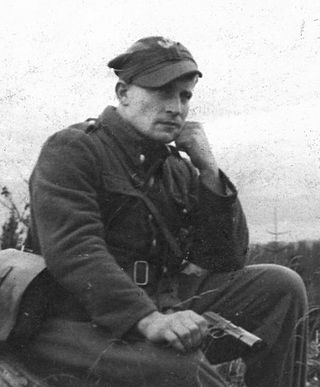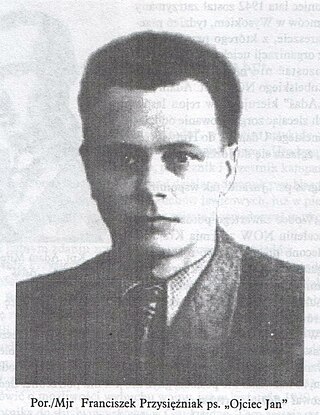
National Armed Forces was a Polish right-wing underground military organization of the National Democracy operating from 1942. During World War II, NSZ troops fought against Nazi Germany and communist partisans. There were also cases of fights with the Home Army.

Zygmunt Szendzielarz was the commander of the Polish 5th Wilno Brigade of the Home Army and after the Second World War fought against the Red Army.

Poland was invaded and annexed by Nazi Germany and the Soviet Union in the aftermath of the invasion of Poland in 1939. In the pre-war Polish territories annexed by the Soviets the first Soviet partisan groups were formed in 1941, soon after Operation Barbarossa, the German invasion of the Soviet Union. Those groups fought against the Germans, but conflicts with Polish partisans were also common.

The "cursed soldiers" or "indomitable soldiers" were a heterogeneous array of anti-Soviet-imperialist and anti-communist Polish resistance movements formed in the later stages of World War II and in its aftermath by members of the Polish Underground State. The above terms, introduced in the early 1990s, reflect the stance of many of the diehard soldiers.

The anti-communist resistance in Poland, also referred to as the Polish anti-communist insurrection fought between 1944 and 1953, was an anti communist and anti-Soviet armed struggle by the Polish Underground against the Soviet domination of Poland by the Soviet-installed People's Republic of Poland, since the end of World War II in Europe. The guerrilla warfare conducted by the resistance movement formed during the war, included an array of military attacks launched against communist prisons, state security offices, detention facilities for political prisoners, and prison camps set up across the country by the Stalinist authorities.

Józef Kuraś, noms-de-guerre "Orzeł" (Eagle) and from June 1943 "Ogień" (Fire), was born in Waksmund near Nowy Targ. He served as lieutenant in the Polish Army during the invasion of Poland, and became an underground member of Armia Krajowa and Bataliony Chłopskie in the Podhale region. After the end of World War II, he continued his fight against the Communist authorities and was one of the leaders of the so-called "cursed soldiers".

Andrzej Piotr Pityński was a Polish-American monumental sculptor who lived and worked in the United States. A book of his works was published in 2008.

Danuta Helena Siedzikówna was a Polish medical orderly in the 4th Squadron of the 5th Wilno Brigade of the Home Army. In 1946 she served with the Brigade's 1st Squadron in Poland's Pomerania region. Considered a national heroine, she was captured, tortured and sentenced to death at the age of 17 by the communist authorities.

Franciszek Przysiężniak - was a lieutenant in the Polish Army, an officer of anti-communist resistance groups National Military Organization (NOW) and National Military Union (NZW).

The Katyń Memorial is a bronze statue created by Polish-American sculptor Andrzej Pitynski in dedication to the victims of Stalin's March 5 1940 Katyn massacre in which thousands of Polish Army officers and intellectual leaders who had been interned at Kozielsk or imprisoned at Ostashkov and Starobielsk had been killed by the occupying Soviet People's Commissariat for Internal Affairs, or NKVD. The memorial stands at Exchange Place in Jersey City, New Jersey, United States, near the mouth of the Hudson River. Unveiled in June 1991, the statue depicts a bound and gagged Polish soldier with a bayoneted rifle impaled through his back. The statue stands 34-foot-tall (10-meter) and is atop a granite base containing Katyn soil. Its base also depicts a Polish woman carrying her starving child in memorial to the Polish citizens deported to Siberia that began shortly before the massacre.

Brigadier General Thaddeus Kościuszko is a bronze statue honoring Polish military figure and engineer Tadeusz Kościuszko. The sculpture was dedicated in 1910, the third of four statues in Lafayette Square, Washington, D.C., to honor foreign-born heroes of the American Revolutionary War. Born in the Polish–Lithuanian Commonwealth in 1746, Kościuszko later received education at a Jesuit school before attending the Corps of Cadets in Warsaw. He later traveled to France where he studied in military academy libraries and adopted views of human liberty during the Age of Enlightenment. He moved to the Thirteen Colonies in 1776, where the war with the Kingdom of Great Britain had already begun. Kościuszko served as an engineer in the Continental Army, earning the praise of his superiors, including General George Washington.

General Casimir Pulaski is a bronze equestrian statue of Casimir Pulaski, a military man born in the Polish–Lithuanian Commonwealth. He joined the military at a young age, fighting for removal of the king, who was backed by Russia. After his side lost the war, he fled to Paris, where he met Benjamin Franklin. Impressed by Pulaski, Franklin wrote a letter of recommendation to George Washington, suggesting he would be a helpful soldier during the American Revolutionary War. After arriving in the U.S., Pulaski eventually was promoted to Brigadier General and commanded a cavalry unit, the Pulaski's Legion. He died in 1779 due to injuries sustained in battle.

America's Response Monument, subtitled De Oppresso Liber, is a life-and-a-half scale bronze statue in Liberty Park overlooking the National September 11 Memorial & Museum in New York City. Unofficially known as the Horse Soldier Statue, it is the first publicly accessible monument dedicated to the United States Army Special Forces. It was also the first monument near Ground Zero to recognize heroes of the September 11 terrorist attacks.

The National Katyń Memorial is a monument in Baltimore, Maryland, which memorializes the victims of the 1940 Katyn massacre of Polish nationals carried out by Soviet forces. Baltimore's Polish-American community was instrumental in having the monument built. The monument was unveiled in 2000 and is the tallest statue in Baltimore. The statue itself is 44 feet high, the whole monument, with base, is 56 feet.

Abraham Lincoln is a marble sculpture of U.S. President Abraham Lincoln by Irish artist Lot Flannery, located in front of the old District of Columbia City Hall in Washington, D.C., United States. The statue is the nation's oldest extant memorial to the president and was installed several blocks from Ford's Theatre, where Lincoln was assassinated. Flannery was present at the theater on the night of Lincoln's assassination.

The Kościuszko Infantry Division Memorial commemorates the attempt to aid the Warsaw Uprising by soldiers of the Soviet-organised Polish 1st Tadeusz Kościuszko Infantry Division during World War II. It stands at the intersection of Wybrzeże Helskie and Okrzei Streets at the entrance to Port Praski in North Praga in Warsaw, near the former Komora Wodna building on the Vistula river.

Freedom Monument is a monument in Bydgoszcz commemorating both the fallen Soviet and Polish soldiers who fought during the liberation of the city in January 1945, and the return of Bydgoszcz to Poland on 20 January 1920.

The Prince Józef Poniatowski Monument in Warsaw is a monument currently located at 46/48 Krakowskie Przedmieście in the courtyard of the Presidential Palace. Created by Rome-based Danish-Icelandic sculptor Bertel Thorvaldsen in 1829, it depicts Józef Poniatowski (1763–1813) riding and horse and dressed as Roman general.

The 1946 pacification of villages by PAS NZW was the killing of 79 Polish nationals of Belarusian ethnicity in Bielsk County, north-eastern Poland, by partisans, members of the Polish Extraordinary Special Actions unit of the National Military Union. The murders took place in the aftermath of World War II.

The Paweł Adamowicz Square is an urban square in Szczecin, Poland, in the neighbourhood of Centrum, within the Downtown district, between Pope John Paul II Avenue, Independence Avenue, and Aviators Square. It was opened in 2019.




















